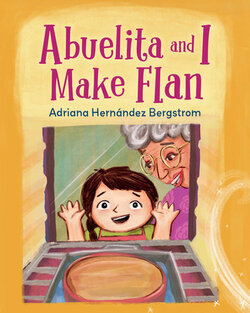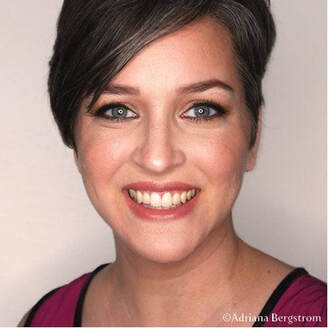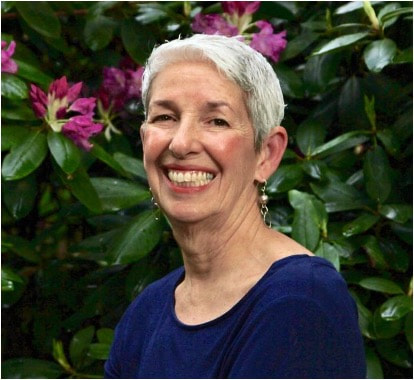|
Today on the blog, we're celebrating Adriana Hernández Bergstrom's Abuelita and I Make Flan. Scroll on to read her interview with Musa Terry Catasus Jennings. First -- a little bit more about this special picture book:  Anita loves to bake with her abuela, especially when they are using her grandmother’s special recipes for Cuban desserts like flan! Anita is making flan for Abuelo’s birthday, but when she accidentally breaks Abuelita’s treasured flan serving plate from Cuba, she struggles with what to do. Anita knows it’s right to tell the truth, but what if Abuelita gets upset? Worried that she has already ruined the day, Anita tries to be the best helper. After cooking the flan, they need a serving dish! Anita comes up with a wonderful solution. Complete with a glossary of Spanish terms and a traditional recipe for flan, Abuelita and I Make Flan is a delicious celebration of food, culture, and family. TERRY CATASÚS JENNINGS: Adriana, I am so happy to be your blog partner for your debut, Abuelita and I Make Flan. It’s a heart-felt story which reminded me so much of my own childhood. Thank you for writing this wonderful story. Is this a story that happened in your childhood? What do you want to tell us about it? ADRIANA HERNÁNDEZ BERGSTROM: Hi Terry! The story is a mixture of real and imagined events. I really did break a wedding dish, but it belonged to my mother, not my abuelita. I really did (and still do!) make a LOT of flan, but it was with my great-aunt, Marta, and sometimes with my aunts or my mom. In real life, I did more crafts like sewing, crochet, and cake decorating with my grandma. I chose flan because it’s delicious and it reminds me of our big family get-togethers which I miss very much. TERRY: You know, I was like you as well in some respects. I learned my cooking from my aunt Bertica. And I do believe that flan is the quintessential Cuban food. It holds so many memories. Why don’t you tell us about your journey to Abuelita and I Make Flan? You have been illustrating for a long time. Give us an idea of your path to publication and to this particular book. ADRIANA: It was a long and winding road! I had a lot of familial expectations and pressure that made it seem like an impossible dream to be an author or illustrator as a career. After high school, my idea was to study illustration and be a children’s book illustrator, but nothing went according to plan. The first semester at the University of Miami, the U shuttered the illustration department and converted into ‘Multimedia’. I was on a full scholarship, so I decided to take advantage of my time there and learned printmaking and theatre production. That choice led to a bunch of other life ramifications…I ended up teaching, studying industrial design, working as a freelance graphic designer, living in Germany… until I finally came back to that dream around 2015. TERRY:, Looking back on my own life, I know that my parents would have wanted me to have a real job, something that could put food on the table regularly. Being an author or an illustrator would have scared them to death. But let’s talk about food. I know through our conversations in Las Musas that Cuban food is very important to both of us. Is this an homage to Cuban food? Is it an homage to your grandmother? ADRIANA: Yes and yes. I was inspired to capture a moment in time where it felt like everything was going wrong as a kid, but still able to find safety and love from my grandparents who accepted me as an imperfect child deserving of love. So in essence, yes, it’s an homage to my grandmother, my family, and the food that made us feel like we belonged. TERRY: And that is what gives this book it’s wonderful heart. That lovely idea of “being accepted as an imperfect child deserving of love.” When did you get the idea of the plate? Without the plate, the story is a beautifully sweet story of love and grandparent/grandchild relationship. I would definitely buy and publish that story, if it was up to me, but maybe my agent would say, you don’t have an arc. The plate gives you an arc. It provides the tension in the book. And it provides an even happier ending. When did the plate come into the story? ADRIANA: Right! And originally I did not have a plate breaking nor the shame of having messed up. I had lots of good feedback on early versions of FLAN, but sometimes the reviewer would say the stakes weren’t very high, it’s missing tension, or that the story was ‘flat’. The summer before I sold the book, I had a brainstorm and remembered when I broke my mom’s wedding plate and how awful I felt. But, I didn’t hide it, in fact, I told her right away. I won’t go into her reaction, but it felt like a symbol to me. I was now a ‘big kid’ and I wasn’t going to hide my mistakes. So, I tried it in FLAN and it worked. It provided the necessary missing tension to move the story along. TERRY: Anita isn’t only learning to make flan, but she is learning about her heritage. To me, once they use the plate that she made for her grandparents as a new flan plate, she becomes part of that heritage. I think that is a beautiful image. Did you mean for that to be part of the takeaway or am I putting words in your mouth? ADRIANA: That is exactly it! Anita is meant to be a part of the continuity of the family. Like the branches of the family tree before her, she is as valid a member of the family as those that came before. Because it doesn’t matter where we are, we are still family, still connected. We are not in the land of our ancestors anymore, but we create new traditions wherever we are. TERRY: I love creating new traditions wherever we are. One really stand-out character for me was Abuelo. He does Judo!!! And his picture in the book is so cool. That particular photograph brings the reader in to know that this is a true story. Real people. It has so much more meaning. Do you want to share your thoughts about your grandfather and your relationship? ADRIANA: I have a seed of a story that’s Abuelo and Anita that I hope I get to tell one day. The judo element is at the heart of something that was always so interesting to me about humanity. We all contain multitudes. We all have everyday stories and backstories, and the people we encounter every day live completely full lives independent of our own. As a kid, I was enthralled by this. I would get very lost in my mom’s high school yearbook and my grandparents’ albums wondering about the lives they lived before I ever knew them. My grandfather had a troubled childhood and sometime in the 1920’s, Japan sent ambassadors to Cuba to teach judo as a way of building friendships with other nations. It became an outlet for my grandfather who flourished under the guidance and discipline of a judo practice and meditation practice. He passed on the meditation practice but refused to teach me judo! TERRY: Well, now, you’ve taught me a bit of our history that I never knew. Thank you! You have been shaped by not only Cuba and the United States, but you lived in Germany for a long time. Can you tell us what or whether that has added to your journey? ADRIANA: Living in Germany, I gained a deeper understanding of what it means to learn a new language and adapt to a new culture as an adult. I understood to a tiny degree what it meant for my family to leave everything and move to another country with hope of a better future in your heart. I miss the safe feeling of everyday life in Germany and I miss my friends. I also learned a lot about how a country rebuilds after a great tragedy. TERRY: I get that. And I have seen, just in travels, the amazing job that Germany has done of rebuilding. They are admirable. Now let’s talk about your relationship to your abuelita. Do your own children have an abuelita and an abuelito? What is their relationship and how does it compare to your own? ADRIANA: I was raised by my grandparents. My mom worked nights for a while and so my mom would drop us off and we’d stay in after school care or Abuelita picked us up from school. We all lived in the same house for most of my childhood, and my mom was a single mom until I was 17. The grandkids have a really, really different relationship with their grandma. TERRY: Tell me about the recipe for flan. In my family, my cousins and I, who are the top generation left of the Melendez women, have been known to have flan bake offs. When we get together for a weekend, we all make our flans using our different recipes and different ways. Was this recipe part of your family or is this something you perfected yourself? To be honest, I have never had a flan with cream cheese, although, I do know that cream cheese is something that my mother used on everything. I see that the recipe is five eggs, which is what I use, but I only use half a cup of sugar for the caramel. And you put it in the blender! Brilliant. You taught me something. I always beat it with a whisk, and I must admit, my texture isn’t optimal. Those are some of the differences in making flan. ADRIANA: Ah! Yes! So, yes, there was a Rodriguez v Quesada rivalry for us. My Tía Ines and my great-aunt Marta would unofficially have bake-offs. Marta claimed to be the queen of flan, and pastries in general, but she’d use the dry method of making caramel and often it would be pretty bitter! So, as a little girl, I would refuse to eat her caramel sauce and ask for Tía Ines’s which was sweeter. Tía Ines added a splash of water to the sugar to prevent burning. And this led to some rivalry between the two because Ines would tell Marta that the kids all ate her flan. In the recipe included with the book, the addition of the cream cheese is to give beginners a high success rate with the flan. The queso crema acts as a binder, stabilizer and adds richness. My mom’s best friend Gisela would add it to be sure it would set. If you’re doing the classic flan de leche, then you can just omit the cream cheese. Also, if you’re getting lots of bubbles all up the sides of the custard, your heat might be too high! Low and slow is the best way to go! TERRY: Thank you for that tip. I do make my caramel the dry way, but under very low heat. If it ever burns, I throw it out and start over. Now let’s talk about cooking. Cooking is important to both of us. I express my love through food. Whenever I don’t know what to do to help someone, I cook. I wonder whether you feel that way. Is this a personal thing, or is this a Cuban thing? ADRIANA: Oh my goodness! Is it a Cuban thing? I don’t know, but I do the EXACT same thing. I jokingly call it ‘procrastibaking’ when I can’t figure out the solution to something and bake instead of ruminating. It’s one of the few activities that I can just focus on and make something while subconsciously processing something else! TERRY: Let’s talk in more detail about your art. What would you want our readers to know about your process and what it means to you. ADRIANA: My artwork is always evolving. I love capturing textures that are real and mixing them with digital media and back and forth (analog and digital). I think traditional media informs my digital work and vice versa. TERRY: Can you tell us more about your other published work? ADRIANA: I am so excited about my next book TUMBLE that comes out in 2023 published by Scholastic. It’s the first time I’ve worked on a nonfiction book! TERRY: Abuelita could be any one of the many Cuban grandmothers I have known. She is perfect. I love her chancletas. Brava. Was she a composite or was she taken from real life? Abuelo? ADRIANA: Aww thank you for saying so. The Abuelita character was drawn from a combination of several real-life people including my great aunt, Marta, and a mixture of both my grandmas (paternal and maternal). Abuelo is a mixture of my maternal grandfather and my late stepfather. TERRY: What is in the future for you? Tell us about what you can tell and what you can’t tell. Is food involved? ADRIANA: Hah! I’d love to illustrate more food books! I have one project I mentioned earlier, a nonfiction book TUMBLE (2023, Scholastic), and then I have another project that I can’t share yet which does have food and I cannot wait to talk about it! TERRY: Adriana, it has been a pleasure interviewing you and I love your book. I love being with you in Las Musas. All the best to you, I’ll be here to cheer you on. ADRIANA: Thanks, Terry! Thanks for a lovely interview. Wishing you the best – see you in Las Musas! Buy Abuelita and I Make Flan today!  Adriana Hernández Bergstrom is a Cuban-American mixed-media illustrator and designer. A lifelong learner, she studied industrial design at RISD (‘08) and fine art & theatrical set design at the University of Miami, FL. She loves literacy and languages and speaks English, Spanish, and German. Adriana is represented by Wernick & Pratt literary agency. For all inquiries related to publishing please contact: info(at)wernickpratt(dot)com .  Terry Catasús Jennings is a Cuban-American writer who immigrated to the United States after her father was jailed in Cuba by Fidel Castro’s government. She was twelve at the time and knew no English. The Little House of Hope/La casita de esperanza is a semi-autobiographical story in which immigrants give each other a helping hand in a new country. Her goal in life is to lead us to embrace our common humanity, as well as sing the praises of Cuban food. Terry is represented by Natalie Lakosil of Irene Goodman Literary Agency.
1 Comment
9/14/2022 04:48:56 am
Thank you so much for sharing this! It is so inspiring and we got a lot of ideas. This is also a must read for all people who's looking for an <a href="https://www.windsongtagaytay.com" title="event's place" alt="event's place">event's place</a> that is perfect for any kind of occasion. Kudos!
Reply
Leave a Reply. |
Las Musas SpeakWelcome to our blog! Archives
July 2024
Categories
All
|

 RSS Feed
RSS Feed